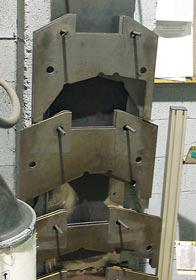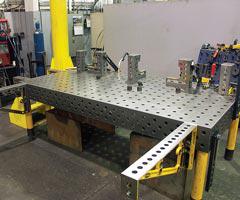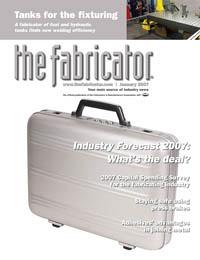- FMA
- The Fabricator
- FABTECH
- Canadian Metalworking
Categories
- Additive Manufacturing
- Aluminum Welding
- Arc Welding
- Assembly and Joining
- Automation and Robotics
- Bending and Forming
- Consumables
- Cutting and Weld Prep
- Electric Vehicles
- En Español
- Finishing
- Hydroforming
- Laser Cutting
- Laser Welding
- Machining
- Manufacturing Software
- Materials Handling
- Metals/Materials
- Oxyfuel Cutting
- Plasma Cutting
- Power Tools
- Punching and Other Holemaking
- Roll Forming
- Safety
- Sawing
- Shearing
- Shop Management
- Testing and Measuring
- Tube and Pipe Fabrication
- Tube and Pipe Production
- Waterjet Cutting
Industry Directory
Webcasts
Podcasts
FAB 40
Advertise
Subscribe
Account Login
Search
Moving to modular welding fixturing
Process control improvement drives tank fabricator
- January 9, 2007
- Article
- Arc Welding
Wrayco Industries Inc. specializes in fabricating fuel and hydraulic tanks for heavy equipment such as backhoes, excavators, large off-road trucks, and generator and pump sets. It also manufactures tanks for specialty over-the-road applications from 0.16- to 0.47- inch mild steel plate, stainless, and aluminum.
The Ohio-based company, founded in 1980, originally occupied 16,000 square feet and had five employees. Now it occupies more than 40,000 sq. ft. with about 190 employees and is projecting a quadrupling in sales over the next five years. In the next 18 months, Wrayco will add another 160,000 sq. ft. to its existing facility, along with 100 new employees.
A Shop Floor That Flows
Gary Gibb, president and CEO of Wrayco Industries, created his operation to be one that major OEMs can relate to.
"OEMs see lean manufacturing; state-of-the-art equipment; tight process control; and large, open spaces," Gibb said "It's a continuous flow. We have no enclosed spaces which foster fiefdoms. All employees are cross-trained to keep everyone as productive and quality-conscious as possible. When you walk the floor, you see lasers, forming, welding, and painting, all in one continuous flow."
And according to Gibb, this approach almost sells itself.
Because many tanks, such as those for backhoes and excavating, are similar, OEMs can take advantage of economies of scale. "We have press brake dies designed to handle that commodity, automation, state-of-the-art paint lines with a zinc phosphate pretreat, and a patent-pending tank cleaning and conversion coating process for interior surfaces called Wraycosizing," Gibb said.
Modular Welding Fixturing
One area Wrayco recognizes as an opportunity for significant process improvement is welding fixturing. From prototyping to production runs, the fabricator rarely outputs tanks that are identical, and making dedicated fixturing for each new product type has numerous drawbacks.
"We wanted to improve our welding fixturing operation logistically and financially," Gibb said. "We had about 10,000 square feet allocated to noncurrent dedicated fixtures and didn't want to put money into storing them vertically. Dedicated fixtures are a storage and maintenance problem and a drain on productivity. My objective was to improve the productivity of everything surrounding them and to eliminate as many as possible."
While attending the 2000 International Manufacturing Technology Show, Gibb noticed a Bluco modular welding fixturing system. "It seemed capable of delivering the fixturing improvements we needed," he said.
Wrayco's first modular welding fixturing purchase in 2000 comprised one 5- by 10-ft. Demmeler D28 system table and a components kit. Since then the fabricator has purchased more systems and has used the supplier's rental program to explore different modular configurations. The fabricator currently owns eight table-based systems and two robot-based systems ,with more planned.
The table system is based on a five-sided, high-strength-steel table with a grid of accurately located, 1.1-in. bores on 3.9-in. centers; a pattern of grid lines across the top; and a scale etched on all four edges to aid setups. Table flatness is 0.004 in. overall, and the bores are located ±0.001 in. hole to hole and ±0.002 in. overall. System angles and blocks can be attached to the sides of the table as outriggers for parts larger than the table's surface.
Fixture elements are engineered to precision-match the table's hole-and-grid pattern for quick setup and easy removal. Structural pieces have slots to locate fixtures between holes. Positioning and clamping bolts attach fixtures, workpiece positioners, and other elements to the table or to each other. The hardened clamping bolts provide up to 3 tons of clamping force and can withstand 25 tons of shear.
Fabricating Excavator Fuel Tanks
Fabricating excavator fuel tanks is one application Wrayco uses modular fixturing for. The finished part is 4- by 4- by 10-ft. mild steel. Its large area and complex surfaces require the joining of numerous pieces. To accomplish this, Wrayco uses an ABB robotic gas metal arc welding machine for finish welding.
The tank is tack-welded before going into the cell. It's then fixtured to the robot's vertical positioner (rotary table) for optimal presentation to the "skyhook" welding arm (see Figure 1). The fixture incorporates a modular U-form spacer block attached to the vertical positioner and is free to rotate on two axes. Mounted to the U-form spacer block are several modular angles attached to a Wrayco-built, laser-cut locating device designed to interface with the modular fixturing hardware (see Figure 2).
The result is a cradle that matches the underside of the tank to which it's securely clamped. This configuration gives the robot complete access to all tank surfaces, enabling it to complete all the welds in one operation. Wrayco said it achieves a consistent weld profile at considerably faster rates because of its accurate, reliable fixturing.
Modular Fixturing for Fast Prototypes
"Modular welding fixturing enables us to be very responsive, which is particularly impressive to customers in the prototyping phase," Gibb said.
"Traditionally, most manufacturers can't afford to build dedicated prototype fixtures because the part isn't worked out yet. Engineering changes come at you fast and furious, and you've got to compensate to make a proper part."
Wrayco found that the modular fixturing is ideal for prototyping because the table acts as its own built-in metrology and inspection gauge. Because of the regular pattern of bores around the top and the sides of the table, once the process is established and has made a good part, part geometry can be extracted and used to document the fixture and the process.
Fixturing a fuel tank base requires a 4- by 8-ft. table. The part is larger than the fixture table surface, but the table is five-sided with a pattern of bores on all four sides and the top. This enables side mounting of standard modular angles horizontally off the side as outriggers. As a result, a 4-ft.-wide table can accommodate a 9-ft.-wide part (see Figure 3).
A second view of the tank base fixturing arrangement in Figure 4shows how components are positioned using modular elements with swing-away locators. Squareness and positioning accuracies result from accurately machined bores in the table surface and sides, as well as from the stability of the system's modular, cast steel angles and 31.50-in. black bars used as end stops.
Investment in Precision Pays Off
According to Wrayco, progression from dedicated welding fixturing to modular fixturing has reduced storage space and maintenance, created faster setups for critical prototypes and quick-turn projects, and improved quality control.
"A customer from an overseas facility of a major domestic heavy-equipment manufacturer visited to check progress of a critical prototype. He said he couldn't believe we had turned the project so quickly," Gibb said.
"According to conventional wisdom, you can't efficiently run a robot on short runs. But the robot doesn't know that. You load in a program and the robot goes where it's supposed to go," Gibb said. "If you can contrive a way to fixture short runs accurately, you can apply welding automation to great competitive advantage."
Related Companies
subscribe now

The Fabricator is North America's leading magazine for the metal forming and fabricating industry. The magazine delivers the news, technical articles, and case histories that enable fabricators to do their jobs more efficiently. The Fabricator has served the industry since 1970.
start your free subscription- Stay connected from anywhere

Easily access valuable industry resources now with full access to the digital edition of The Fabricator.

Easily access valuable industry resources now with full access to the digital edition of The Welder.

Easily access valuable industry resources now with full access to the digital edition of The Tube and Pipe Journal.
- Podcasting
- Podcast:
- The Fabricator Podcast
- Published:
- 04/16/2024
- Running Time:
- 63:29
In this episode of The Fabricator Podcast, Caleb Chamberlain, co-founder and CEO of OSH Cut, discusses his company’s...
- Industry Events
16th Annual Safety Conference
- April 30 - May 1, 2024
- Elgin,
Pipe and Tube Conference
- May 21 - 22, 2024
- Omaha, NE
World-Class Roll Forming Workshop
- June 5 - 6, 2024
- Louisville, KY
Advanced Laser Application Workshop
- June 25 - 27, 2024
- Novi, MI



































